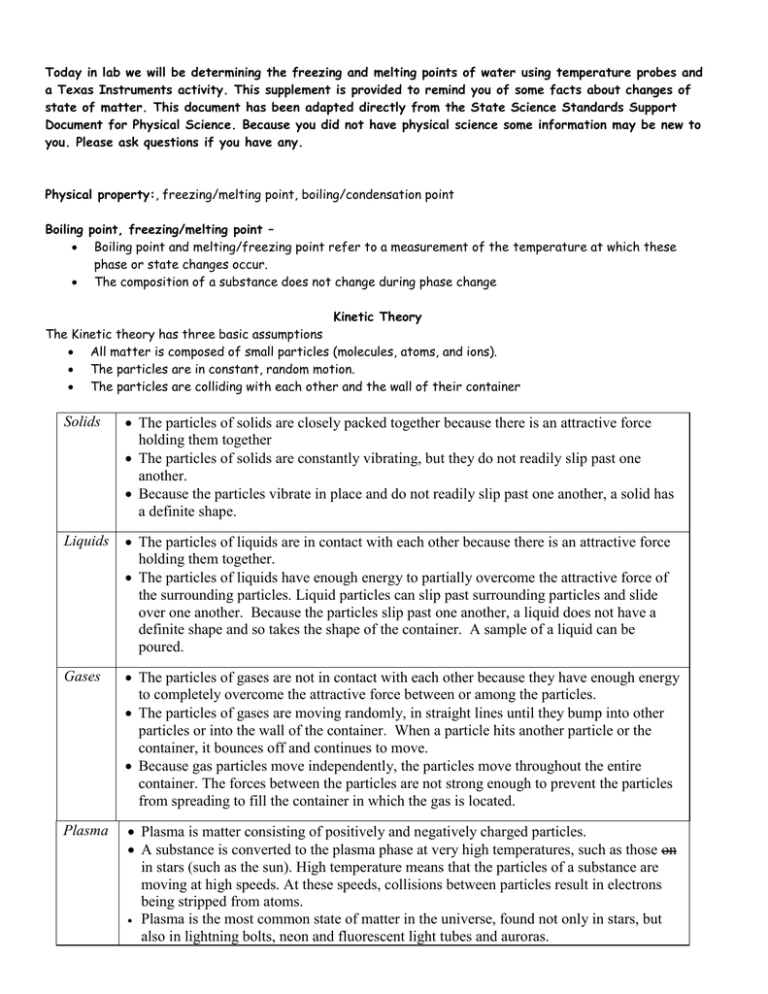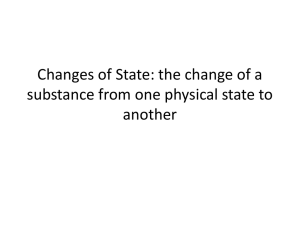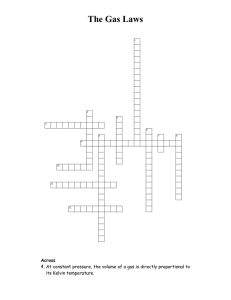Solids • The particles of solids are closely packed together because
advertisement

Today in lab we will be determining the freezing and melting points of water using temperature probes and a Texas Instruments activity. This supplement is provided to remind you of some facts about changes of state of matter. This document has been adapted directly from the State Science Standards Support Document for Physical Science. Because you did not have physical science some information may be new to you. Please ask questions if you have any. Physical property:, freezing/melting point, boiling/condensation point Boiling point, freezing/melting point – Boiling point and melting/freezing point refer to a measurement of the temperature at which these phase or state changes occur. The composition of a substance does not change during phase change Kinetic Theory The Kinetic theory has three basic assumptions All matter is composed of small particles (molecules, atoms, and ions). The particles are in constant, random motion. The particles are colliding with each other and the wall of their container Solids The particles of solids are closely packed together because there is an attractive force holding them together The particles of solids are constantly vibrating, but they do not readily slip past one another. Because the particles vibrate in place and do not readily slip past one another, a solid has a definite shape. Liquids The particles of liquids are in contact with each other because there is an attractive force holding them together. The particles of liquids have enough energy to partially overcome the attractive force of the surrounding particles. Liquid particles can slip past surrounding particles and slide over one another. Because the particles slip past one another, a liquid does not have a definite shape and so takes the shape of the container. A sample of a liquid can be poured. Gases The particles of gases are not in contact with each other because they have enough energy to completely overcome the attractive force between or among the particles. The particles of gases are moving randomly, in straight lines until they bump into other particles or into the wall of the container. When a particle hits another particle or the container, it bounces off and continues to move. Because gas particles move independently, the particles move throughout the entire container. The forces between the particles are not strong enough to prevent the particles from spreading to fill the container in which the gas is located. Plasma Plasma is matter consisting of positively and negatively charged particles. A substance is converted to the plasma phase at very high temperatures, such as those on in stars (such as the sun). High temperature means that the particles of a substance are moving at high speeds. At these speeds, collisions between particles result in electrons being stripped from atoms. Plasma is the most common state of matter in the universe, found not only in stars, but also in lightning bolts, neon and fluorescent light tubes and auroras. Phase (or State) Change. Key Concepts: Phase change (in terms of energy), Temperature change (in terms of energy), Boiling point, Freezing/Melting point, Heat Energy (potential energy and kinetic energy) Temperature is a term used to describe the average kinetic energy of the particles in a substance. The faster particles are moving the higher the temperature. Phase change in terms of The Kinetic Theory Phase change is due to changing the movement (energy) of the particles. The freezing or melting point is the temperature where a phase change occurs between a liquid and a solid. If heat is being added at this temperature intermolecular forces between particles will be overcome and a solid will melt. If heat is being taken away bonds will form between particles and a liquid will freeze at this temperature. The boiling point is the temperature where a liquid is changing to a gas throughout the liquid. This phase change can occur at any temperature. Boiling occurs when bubbles of the vapor are formed. When energy (such as heat) is added to a substance, the kinetic energy of the particles of the substance increases. Evidence of this would be that the temperature of the substance increases or a phase change. When heat is added to a solid the particles will move faster and the temperature will increase until the temperature of the solid reaches its melting point. When the temperature of a solid is equal to the melting point and more heat is added to the substance the temperature will not change. The extra heat will be used to overcome some of the intermolecular forces among the molecules of the solid and change the phase to a liquid. When heat is added to a liquid the particles will move faster and the temperature will increase until the temperature of the liquid reaches its boiling point. When the temperature of a liquid is equal to the boiling point and more heat is added to the substance, the temperature will not change. The extra heat will be used to break down the intermolecular forces among the molecules of the liquid and change the phase to a gas. When a substance boils, it forms bubbles of the gas. (For example when water boils, the bubbles are filled with water vapor.) Figure 1. Heat Energy added over time The changes shown on a temperature versus time graph that shows boiling point and melting/freezing point. The line of the graph has a positive slope until a phase change occurs. At the melting point or boiling point the temperature does not change as more heat is added over time. The slope of the line will be flat during the time that the phase is changing. After the phase change the slope of the line becomes positive again .


